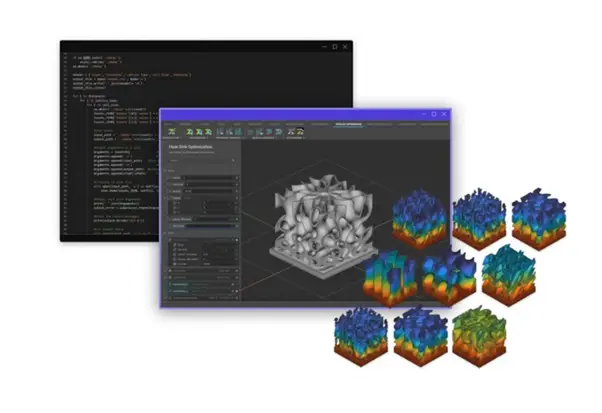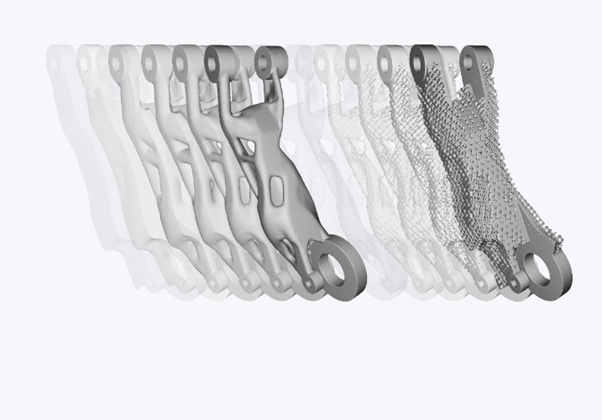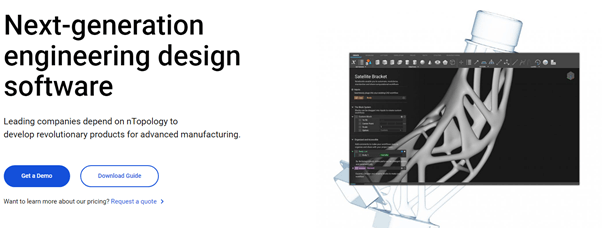The product design industry is constantly evolving with generative design software. Designers and engineers use this program to optimize the creation process with artificial intelligence (AI), eliminating errors and overcoming limitations.
This software combats the most challenging advanced manufacturing and engineering problems. Engineers also use it to design the most complex structures.
If you aren’t familiar with generative design software, this article will help. It covers the program, how it works, and selecting the best generative software.
Let’s get started.
What is Generative Design Software?

A generative design software is an AI-powered tool designers use for inputting goals, performance requirements, manufacturing methods, etc., to generate designs. It explores different sequences to produce other creative options. Also, it evaluates and learns from reoccurrences to make the perfect models.
How Does Generative Design Software Work?
The generative design software functions through the following processes:
- Data input: The designer inputs design details, including goals, limitations, and constraints. Afterward, they add facts about its weight, cost, material, and product’s strength.
- AI function: After inputting the required information in the software, the AI gets to work. Consequently, the computer system and AI generates many designs based on the details in the program.
- Human adjustment: Designers or engineers review the generated designs to make corrections where necessary. If they aren’t satisfied with the output, they make iterations till they achieve a satisfactory result.
- Prototype production: Designers create a prototype after making necessary corrections to the designs. Then, they evaluate the prototype after development for approval. Otherwise, they return to the initial stage for the production.
Tips for Selecting the Best Generative Software

It’s easy to use generative software if you already have a basic knowledge of computer-aided designs (CAD) tools. However, choosing the best program is essential to achieving the expected outcome. Here are some tips to ensure you make the right choice.
1. Consider if the Software will Support Other Applications
It’s critical for generative software to integrate other applications for optimal use. You can centralize all functions into a single software solution with proper integration.
This allows you to perform different processes from a platform, thereby saving time and effort. Therefore, ensure the generative software supports the major applications you use to improve workflow and save time and resources.
2. Check if it’s Easy to Use
Generative design software should offer a straightforward and simple-to-use experience. If its interface is intuitive and easy to navigate, you can easily optimize features and perform tasks faster.
Before selecting this software, check if its interface is easy to use with uncomplicated processes. Can you get started quickly? Can you perform all functions without aid? These questions will help you identify the best easy-to-use generative design tool.
3. Ensure it Reduces Design Cost
Advanced software like generative design tools offers sophisticated algorithms and optimization that manage materials. Features such as plate inventory management, work order processing, automatic nesting, and other components come with some generative design software, helping you regulate materials and save resources.
Therefore, ensure it is equipped with features that update material consumption to maximize products effectively. It limits your expenses.
Additionally, the traditional design process involves repetitive testing and evaluation. After developing a technique, you have to test it many times for perfection. However, with generative design, testing occurs during AI computation to produce only viable structures, helping you skip the cost associated with design changes.
4. Confirm that it Streamlines Processes
An excellent generative design tool comes with AI-powered systems that produce different techniques faster than humans. Therefore, it should reduce the development time to boost productivity.
So, when choosing a generative design tool, ensure it offers efficiency through its speed. For example, find out how long it takes to generate designs and how many products it can produce simultaneously.
5. Ensure it Explores Simultaneously
It’s best to carefully evaluate and compare all options when using generative design software. Therefore, explore tons of structures simultaneously during the design process. This lets you analyze and choose the layout that meets your needs.
6. Check that it Produces Advanced Designs
Make sure the generative design software features to support complex designs. It should have advanced functions for designing separate product parts and combining them later. For example, you can integrate different elements to make intricate dimensional designs.
7. Consult a Professional’s Help
Working with an expert’s guideline helps you choose an effective generative design software. Also, professionals have deep insight into the features to look out for based on your goals.
Therefore, seek a generative design expert’s guidance. Discuss your expectations and goals and let them guide you to select the right tool for your needs.
Benefits of a Generative Design Software
There are several advantages of using a generative design tool. Let’s take a look at some of them:
-
It’s Easier to Make Changes
Unlike traditional design tools, it’s easier to edit, change, improve prototypes and existing designs with this software than conventional tools. It automates every change, so you don’t have to go through the rigorous editing process manually.
Instead, you can input design features, goals, and constraints, then make changes automatically. Also, while other types of software may require time to customize and edit, a generative design tool speeds up this process by automating tasks.
-
Makes Better Designs
Generative design software helps engineers and developers produce the best products. They identify and improve on mistakes to create products that meet expectations.
Besides, engineers can explore other excellent options to select the best because it offers different design alternatives. The software also improves itself through every iteration process. So, by adjusting configurations, you upgrade the software to create effective products.
-
Aids Productivity
Product development is often time-consuming because it requires several processes. However, generative designs automate activities, so it’s faster to produce results.
You can create multiple formats at the same time, so instead of creating products individually, you can develop various designs simultaneously to save time. This helps you get more things done, enhancing your productivity.
-
Increases Efficiency and Reduces Cost
Generative design tools produce faster results by creating several designs at a low time frame. As a result, you can cut costs by reducing the workforce, time, and other resources.
First, it streamlines the activity through automation, requiring less manual work. Also, a design requiring several workers with traditional tools will demand a few employees, thereby cutting hiring costs.
Second, generative design software reduces the number of testing and simulations, decreasing the number of iterations required. So, there’s no need to run tests and simulations after a design is completed, as the finished product meets expectations.
-
Boosts Creativity
Generative design tools spark creativity by providing several ideas. So, if you run out of concepts, browse the options available to choose the perfect technique for your needs. Again, these designs are customizable, so you can tweak available products for one that matches your requirement.
-
Gives a Competitive Edge
Generative design software is an advanced technology that represents the future of the innovation industry. It will continue to develop in various areas to help designers and engineers improve their products because of AI technology.
Therefore, embracing this tool gives you an edge over designers who don’t. It lets you develop unique and professional designs, thereby helping you stand out in the industry.
Applications of Generative Design Software

Several industries use generative design tools. Below are the most common:
-
Sports Equipment Industry
The invention teams in the sports equipment industry use generative design tools to produce high-quality products. Consequently, they minimize production costs with the software.
-
Aerospace
Aviation engineers use generative design software to decrease aircraft mass while maintaining its durability. This software develops sturdy and durable designs.
-
Automotive industry
Generative design tools let automotive engineers produce the best automobiles. Often, they make structural and mechanical components, reducing their overall mass while maintaining their durability.
-
Architecture
Architects use this software to eliminate common design challenges. It provides solutions to their needs and allows them to produce the best designs according to their preferences.
-
Medicine
Medical engineers use generative design tools to produce high-efficiency implants and other devices for treatments.
-
Mechanical Engineering
Mechanical engineers creating special equipment and tools use this software to develop virtual designs. By doing this, they facilitate the production process for fast results.
Best Generative Design Software

Different types of generative design software are available. But if you’re looking for an easy-to-use and functional tool, the nTopology design software tops the list. Engineers in the automotive, medical, aerospace, etc. industries use it to develop efficient designs.
It gives designers and engineers total control over the development process. It allows them to create usable workflows based on their goals and needs.
It also offers features like analysis simulations, reusable design workflows, etc. As a result, you can accelerate the design process, make rapid innovations, and produce advanced geometry and design data.
So, use NTopology if you are looking for a field-driven design, efficient geometry, and customizable workflows.
Conclusion
A generative design tool is useful for every designer and engineer who produces excellent products. It boosts productivity by automating tasks, increases efficiency, reduces production costs, etc.
When selecting a functional design software, check out its intuitiveness, integration features, automation, among others. Considering these factors will help you choose the best generative design tool.
Author Bio:
 Lydia Iseh is a writer with years of experience in writing SEO content that provides value to the reader. As someone who believes in the power of SEO to transform businesses, she enjoys being part of the process that helps websites rank high on search engines.
Lydia Iseh is a writer with years of experience in writing SEO content that provides value to the reader. As someone who believes in the power of SEO to transform businesses, she enjoys being part of the process that helps websites rank high on search engines.



